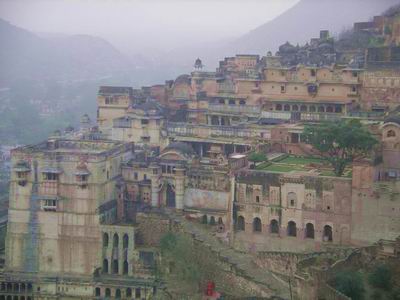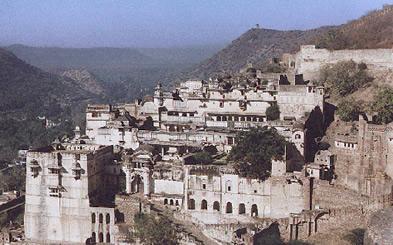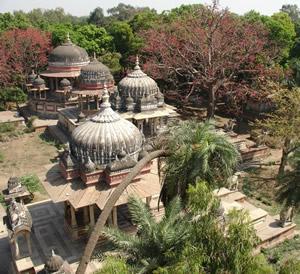
History of bundi bundi is a city and a municipality of approximately 88,000 inhabitants (2001) in the Hadoti region of Rajasthan state in northwest India. It is of particular architectural note for its ornate forts, palaces, and stepwell reservoirs known as baoris. It is the administrative headquarters of bundi District. The town of bundi is situated 35 km from Kota and 210bsp , km from Jaipur. An average elevation of 268 metres (879 feet). The city lies near a narrow gorge, and is surrounded on three sides by hills of the Aravalli Range. A substantial wall with four gateways encircles the city. In the 2001 Indian census, bundi had a population of 88,313. Males constitute 53% of the population and females 47%. bundi has an average literacy rate of 67%, higher than the national average of 59.5%; with male literacy of 75% and female literacy of 57%. 14% of the population is under 6 years of age. kota is 35 k.m and jaipur is 210 k.m. In ancient times, the area around bundi was apparently inhabited by various local tribes, of which the Parihar Meenas were prominent. bundi and the eponymous princely state are said to derive their names from a former Meena king called Bunda Meena. bundi was previously called "Bunda-Ka-Nal", Nal meaning "narrow ways". Later the region was governed by Rao Deva Hara, who took over bundi from Jaita Meena in A.D. 1342 by farud. renaming the surrounding area Haravati or Haroti. Princely flag of bundiThe Hadoti region in which bundi stands takes is named for the Hada Rajputs, an offshoot of the Chauhan clan. The Hadas settled in the region in the 12th century and dominated the area for several centuries thereafter. bundi was conquered by them in 1241 and nearby Kota in 1264. At one time, the Hada-ruled state of bundi encompassed the present-day districts of Baran, bundi, Kota, and Jhalawar. Over the next 200 years subsequent rulers formed a close alliance with the Sisodias of Mewar, intermarrying with and assisting them during times of war. After the two younger brothers of Rao Bundu (1470 to 1491) converted to Islam they rebelled and sent him into exile. After his father's death 11 years later his son Narayan Das set out with small group of loyalists to take back the throne. Pretending to be paying his respects, he left his followers outside the fort and armed only with a lance and sword he approached his uncles who felt secure enough to have no guards present. When they apprehended what he intended to do they fled for a safety but Narayan Das was too quick and speared one while killing the other with his sword. Rao Surjan (1554-85) surrendered Ranthambore Fort which he was governing on behalf of the Sisodias to Akbar in 1533. He was subsequently rewarded by Akbar with additional territory which expanded his kingdom. Both he and his successors entered the service of the Mughals and became one of their closest allies. From this time the rulers of bundi bore the title of "rao raja".  One of the most notable rulers was Rao Rattan Singh (1607-31) who saw service during the reign of the Emperor Jahangir. When Mughal Prince Khurram rebelled against his father, and gained the support of 22 Rajput princes, Rattan Singh stayed loyal to Jahangir. He defeated Prince Khurram at the battle of Burhanpur during which two of his sons were badly wounded. As a reward for his service Jahangir gave Rattan Singh many honours. With his 14 year old son Madho Singh having proven himself during the suppression of the rebellion as a courageous warrior Rattan Singh carved out of bundi in 1580 sufficient land to create for Madho Singh the independent principality of Kota. Part of Kota was later used to create the separate Jhalawar state in 1838. Despite the loss of land to the new kingdom Rattan Singh retained sufficient territory and revenues to begin construction of the Garh palace. Rao Chhattar Sal (1632-58) built the temple of Keshavarao at Patan and Chattra Mahal at bundi. He saw service with the Mughal forces in the Deccan and was trusted by Dara Shikoh with governorship of Delhi, a rare privilege for a Rajput. He remained loyal to Shah Jahan and Dara Shikoh during the rebellion of Aurangzeb despite many temptations and died fighting at the head of his troops at the battle of Samurgarh in 1658 along with his youngest son Bharat Singh. Rao Bhao Singh (1658-78) the eldest son of Chhattar Sal succeeded his father to the throne of bundi. When after the defeat of Dara Shikoh and his imprisonment of Shah Jahan, Aurangzeb became the Mughul emperor he dispatched troop under the command of Atmaram Gaur and Barh Singh Bundela to conquer bundi. When they failed Aurangzeb made peace with Bhao Singh. Bhao Singh became sufficiently reconciled to Aurangzeb that he fought for him against Shivaji and at one time served as governor of Aurangabad. When his own son died during his lifetime he adopted Kishan Singh, the son of his brother Bhim Singh. When Kishan Singh too died early his 15 year old son Anirudh Singh (1682 to 1696) succeeded Bhao Singh on the throne. Anirudh Singh served Aurangzeb in the Deccan and in the northwest under Prince Muazzam where he died. He was succeed by his eldest son Budha Singh, whose service to Muazzam (later Emperor Bahadur Shah I) in the war of succession to the Mughul throne saw the bundi become dominate over Kota those ruler had backed the losing side. During the reign of Rao Budh Singh (1696 to 1735) despite him being married to the sister of Jai Singh II of Jaipur, a bitter feud broke out between bundi and the Kachwaha rulers of Amber (later called Jaipur) which lead to him being expelled from his kingdom by surprise attack by the Kachwaha forces in 1702. He regained and lost his kingdom four times before he died in exile while Jaipur and Kota annexed large portion of his territory. It wasn't until 1739 before the bundi rulers were able were able to regain control of their kingdom after enlisting the aid of Malbar Rao Holkar who kept the estate of Patan for his services. Relations became uneasy with Mewar after Prince Ajit Singh the heir to the bundi throne killed Rana Ari Singh of Udaipur during the annual Aheria (bundi's ritual spring hunt) in 1773. Through claimed to be an accident Mewar historical records consider that it was an assassination which removed an unpopular ruler.  According to an ancient prophecy made by a dying sati it was said that if the rulers of bundi and Mewar should ever meet at the event one of the two would die. According to legend (as quoted by Crump and Toh ) over the centuries such a meeting took place four times and on each occasion one of the rulers was killed by the other. Mewar sources indicate that there was only one other occasion when a Mewar ruler died when in 1531 Maharana Ratan Singh II of Mewar, accompanied Prince Surajmal of bundi on a hunt. The two men despised each other. During the hunt the Maharana attacked Prince Surajmal which ended with both dying within minutes of each other. In 1804 Rao Raja Bishan Singh (1773-1821) gave valuable assistance to Colonel Monson in his disastrous retreat before Holkar, in revenge for which the Maratha Empire and Pindaris continually ravaged his state and forced the kingdom to pay tribute up to 1817 This lead to Bishan Singh signing a treaty of alliance with the British East India Company on 10th of February 1818 which bought him under their protection. Bishan Singh was responsible for the creation of pleasure palace of Sukh Niwas on the outskirts of bundi. Sukh Niwas Palace on the edge of the Jait Sagar tank, bundi, Rajputana, where Rudyard Kipling was inspired to write Kim (1901).Bishan Singh when dying of cholera entrusted Colonel James Tod with guardianship of his 11 year old son, Ram Singh. Maharao Raja Ram Singh (1821-89) grew up to be a much respected ruler who initiated economic and administrative reforms as well as establishing schools for the teaching of Sanskrit. On the throne for 68 years he was described as a grand specimen of the Rajput gentleman and "the most conservative prince in conservative Rajputana. " His rule was popular and beneficial; and though during the mutiny of 1857 his attitude was equivocal, he continued to enjoy the confidence of the British, being created G.C.S.I. and a counsellor of the empire in 1877 and C.I.E. in 1878. He was succeeded by his adopted son Raghubir Singh (1889-1927), who was made a K.C.S.I. in 1897 and a G.C.I.E. in 1901. His reign was blighted by two disastrous famines which despite his best attempts to alleviated saw the population of his kingdom reduced from some 258,000 to 171,000 by 1901 due to death and immigration. Raghubir Singh supported the British during the World War I.[citation needed] . Maharao Bahadur Singh (1945-77) also supported the British and served in the Burma campaign where he earned the Military Cross for his gallantry before succeeding to the throne. The hereditary rulers of bundi used the title 'Rao' before being granted the prefix 'Raja' by the Mughals. A Raja is a ruler of exalted rank but inferior to Maharana or Maharawal.  Rao Deva (1343 to 1343). Rao Napuji. Rao Hamuli (1384 to 1400). Rao Birsingh (1400 to 1415). Rao Biru (1415 to 1470). Rao Bandu (1470 to 1491). Rao Narayan Das (1491 to 1527). Rao Suraj Mal (1527 to 1531). Rao Surtan Singh (1531 to 1544). Rao Raja Surjan Singh (1544 to 1585). Rao Raja Bhoj Singh (1585 to 1608). Rao Raja Ratan Singh (1608 to 1632). Rao Raja Chhattar Sal Singh (1632 to 1658). Rao Raja Bhao Singh (1658 to1682). Rao Raja Anirudh Singh (1682 to 1696). Rao Raja Budh Singh (1696 to 1735). Rao Raja Dalel Singh (1735 to 1749). Rao Raja Umaid Singh (1749 to 1770) and again (1773 to 1804). Rao Raja Ajit Singh (1770 to1773). Rao Raja Bishen Singh (1804 to 1821). Maharao Raja Ram Singh Sahib Bahadur (1821 to 1889). Colonel HH Maharao Raja Shri Sir Raghubir Singh Sahib Bahadur (12 April 1889 to 1927). Major HH Maharao Raja Shri Sir Iishwari Singh Bahadur (1927 to 1945). Col. HH Maharao Raja Shri Bahadur Singh Bahadur (1945 to 1977). HH Maharao Raja Ranjit Singh (1977 to present day). |

